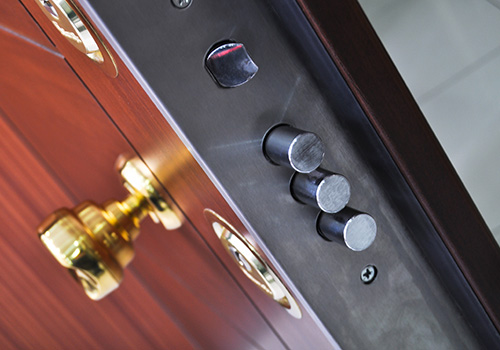Lock Categories
Broadly speaking there are five main lock categories: (1) mechanical key locks, (2) mechanical keyless locks, (3) electronic locks, (4) electro-mechanical locks, and (5) magnetic locks. In this blog post I will focus on the first of these. Within the category of mechanical, key-operated locks there are four types:
- pin-tumblers
- wafer-tumblers
- disc-tumblers
- lever-tumblers
- Pin-tumbler locks are traditionally classified as offering either low or high security, and come in either tubular or linear arrangements. (In tubular pin-tumbler locks the pins are arranged in a circle. In linear pin-tumbler locks they are arranged in a straight line.) Low security, linear pin-tumblers use up to six pin pairs: six key (or bottom) pins and six top (or driver) pins. In this type of lock the operating key raises the bottom pins to the shear line, and thus allows the cylinder to rotate and the locking bolt, latch, or cam to be extended or retracted. High security pin-tumbler locks, in addition to using up to seven pin pairs, use an additional locking component which is either a sidebar (e.g. CX-5), an interactive element (e.g. Mul-T-Lock), or a concealed side pin (e.g. Schlage Everest). (For more examples of popular high security locks go to Security Snobs.) Low security, linear pin-tumbler locks are the most widely used lock type in North America. They are primarily used on residential and commercial doors in rim, mortise, knob, lever, and deadbolt formats.
- Wafer-tumbler locks typically consist of between five and ten spring-loaded wafers that must be either raised or lowered to the top and bottom shear lines before the plug can be rotated to unlock the lock. This type of lock comes in three varieties: single, double, and split. (In actuality there are at least seven different types of wafer-tumbler locks, but for simplicity’s sake we will only look at three here.) In single wafer-tumlber locks each wafer must be lowered to the top shear line before the plug can be rotated to unlock the lock. In double wafer-tumbler locks each wafer must either be raised to the bottom shear-line or lowered to the top shear-line before the plug can be turned. And in split wafer-tumbler locks each half of a wafer pair must be either raised or lower to the same before the plug can be rotated. Single wafer-tumbler locks are commonly found in desk drawers, filling cabinets, and steering wheel clubs. Double and split wafer-tumbler locks on the other hand, are commonly found in automotive ignition, door, and trunk locks.
- Disc-tumbler locks use round slotted detainer discs that interface with a sidebar. These locks are operated using an angle bitted key that aligns the slots (or gates) in each of the eleven or so discs. Once aligned, the sidebar is forced into the slots when the operating key rotates the plug. This allows the bolt, latch, or cam to be extended or retracted. The leading manufacture and inventor of disc-tumbler locks is Abloy. Other manufactures of disc-tumbler locks include: ABUS, Kryptonite, and IFAM. Due to its durability, high level of pick resistance, and bump proof construction, this lock is popular among business owners and government agencies the world over.
- Lever-tumbler locks were at one time the most popular type of lock in the world, but over time they have slowly been replaced in many settings, but not all, by the less expensive and more practical pin-tumbler lock. In this lock each lever, typically between 4 and 7, must be raised to a precise hight (not to high and not too low) to allow the stump on the bolt tail to pass through each lever’s true gate. Once this is done, the key is free to rotate the locks’s curtain to either extend or retract the locking bolt. Though most lever-tumbler locks are operated using single-bitted keys, in high security applications (e.g. safes) double-, triple-, and even quadruple-bitted keys are used. In North America this type of lock is commonly found in antique display cases, safe deposit boxes, and mailboxes. In Europe it is still widely used in mortise locks and padlocks.
The key operated, mechanical locks discussed above have a number of important commonalities. They can all be mastered; with the exception of disc-tumblers, the tumblers are under spring tension; they are rekeyable, and therefore can also be keyed alike; with the exception of lever-tumblers, they all make use of a shear-line and, in high security applications, incorporate the use of a sidebar. Finally, these lock types are available in a variety of formats and can be designed and constructed to meet different budget and production demands; which is why they no doubt continue to be widely used the world over.









